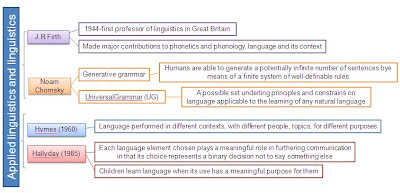
Modern linguistics begins with Ferdinand de aussure; the central continuing notion is that language is a closed sytem of structural relation.
The Prague School, begun in 1926, provided the founddations for most later phonological theory and created the now commonplace notion of distintive features in their analyses. The London School was primarily the product of J.R. Firth, who in 1944 became the first professor of linguistics in Grear Britain.
Firsr proposed a systematic linguistics which made major contibutions to phonetics and phonology as well as to the study use in its situational context.
The Chomsky's theories were:
Generative theory: Proposes that human are able to generate a potentially infinite number of sentences by means of a finite system of well-definable rules.
Universal Grammar: A possible set of underlying principles and constraints on language applicable to the learning of any natural language.
Generalized phrase-structure grammar elaborates the phrasestructure rules to take the place of transformations; the lexical-funtional grammar elaborates the lexical entries to take the place of transformation.
The Halliday's systematic functional theory sayd that each lenguage element chosen plays a meaningul role in furthering communication in that its choice represents a binary decision not to say something else.
Greenberg and Hawkins study how language differ from one another, what generalization may be made cross-linguistically based on the be derived from the patters of typological variation.
Hymess proposed that the real object of linguistics research should be the study of communicative competence (Linguistics should study how language is performed in different contexts, with different people, on different topics and differents purposes.
The traditional articularoty approach is still the basis for most discussion of pronunciation and oral language instruction generally in second-language contexts.
Applied-linguistics research on lexicography, terminology development, second-language acquisition, anf language teaching is still employing descriptive approaches that have been in use for some time.
The descriptive syntax texts have been used for grammar courses and for resourse references in language policity and planning.
The term speech acts refers directly either to sets of verbs that do things when uttered in the right context or to use of utterances in order to convey messages that are only inferrable from a combination of the context and the literal words.
Gricean maxims are typically presented as:
Firsr proposed a systematic linguistics which made major contibutions to phonetics and phonology as well as to the study use in its situational context.
The Chomsky's theories were:
Generative theory: Proposes that human are able to generate a potentially infinite number of sentences by means of a finite system of well-definable rules.
Universal Grammar: A possible set of underlying principles and constraints on language applicable to the learning of any natural language.
Generalized phrase-structure grammar elaborates the phrasestructure rules to take the place of transformations; the lexical-funtional grammar elaborates the lexical entries to take the place of transformation.
The Halliday's systematic functional theory sayd that each lenguage element chosen plays a meaningul role in furthering communication in that its choice represents a binary decision not to say something else.
Greenberg and Hawkins study how language differ from one another, what generalization may be made cross-linguistically based on the be derived from the patters of typological variation.
Hymess proposed that the real object of linguistics research should be the study of communicative competence (Linguistics should study how language is performed in different contexts, with different people, on different topics and differents purposes.
The traditional articularoty approach is still the basis for most discussion of pronunciation and oral language instruction generally in second-language contexts.
Applied-linguistics research on lexicography, terminology development, second-language acquisition, anf language teaching is still employing descriptive approaches that have been in use for some time.
The descriptive syntax texts have been used for grammar courses and for resourse references in language policity and planning.
The term speech acts refers directly either to sets of verbs that do things when uttered in the right context or to use of utterances in order to convey messages that are only inferrable from a combination of the context and the literal words.
Gricean maxims are typically presented as:
Quantity - say as much and not more than you need to
Quality - tell the truth
Relevance - stay on the topic
Manner - be clear and direct
Quality - tell the truth
Relevance - stay on the topic
Manner - be clear and direct

Wendy Saussure.
No hay comentarios:
Publicar un comentario